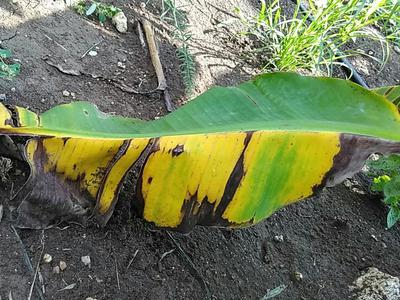Moko Disease
Ralstonia solanacearum
Bacteria
In a Nutshell
- Leaves of infected plants start to wilt, and later collapse.
- A clear, pale yellow to brown discoloration is visible in the vascular region when they are cut open.
- Infected fruits show deformed growth and shrivel up as the pulp is destroyed by dry rot.
- Bacterial ooze becomes visible when fruits are opened.
Can also be found in
Symptoms
Young leaves of infected plants start to wilt, and later die and collapse. The petioles loose strength, resulting in hanging green leaves and poor tree vigor. As the disease progresses, old leaves are affected as well. A clear, pale yellow to brown discoloration is observed in the vascular region when they are cut open. Infected fruits show deformed growth and shrivel up as the pulp is destroyed by a dry rot, visible as dark brown discoloration of the fruit flesh. Bacterial ooze becomes visible when fruits are opened. The bacteria grow in the transport tissues of the tree and impair the movement of water and nutrients to upper plant parts.
Recommendations

Organic Control
The spreading of bleaching powder around the plant can help to contain the progression of the disease. Soils can be drenched before planting with 1% Bordeaux mixture, 0.4% Copper oxychloride or antibiotics such as Streptomycin or Streptocycline (5 g/10 liters). Seedlings can also be treated with 0.4% copper oxychloride (4g/L) for 30 minutes before planting.

Chemical Control
Always consider an integrated approach with preventive measures together with biological treatments if available. There is no direct chemical treatment for the moko disease.
What caused it?
Moko is a banana disease caused by the bacteria Ralstonia solanacerum. It survives in infected plant tissues or other hosts all year round or in soils for periods of over 18 months. High temperatures and high soil moisture generally favor the disease. The spread of the pathogen from tree to tree or between fields can occur in many ways. All plant parts (from root to fruit peel) are a potential source of infection. For this reason, pruning and plant injuries should be avoided. Infected soils, when transported via car tires, tools, footwear or animals, are another source of contamination. Insects or birds that feed on flowers (bees, wasps and fruit flies) and alternative hosts can also transmit the disease. The disease can also spread via irrigation or water runoffs.
Preventive Measures
- Use only healthy plant material from certified sources.
- Monitor the fields regularly for any sign of the disease.
- Remove and burn any plant residues.
- Avoid furrow irrigation and use disinfected water if possible.
- Disinfect cutting tools, footwear and vehicle tires to prevent further spreading.
- Spread 10 % fresh cow dung slurry in the plant basin.
- Remove weeds and Heliconia species from the fields.
- Provide good drainage.
- Leave the soil in fallow for at least 6 months.
- Rotate crops for a period of 12 months.
- Use flowering French marigold as mulch to inhibit the spread of the disease.
- Take care not to damage the plants during field work.



